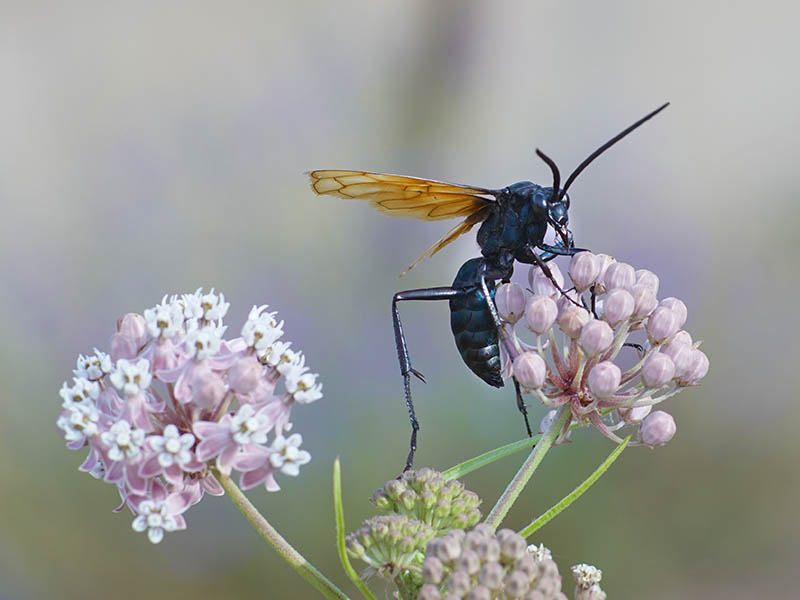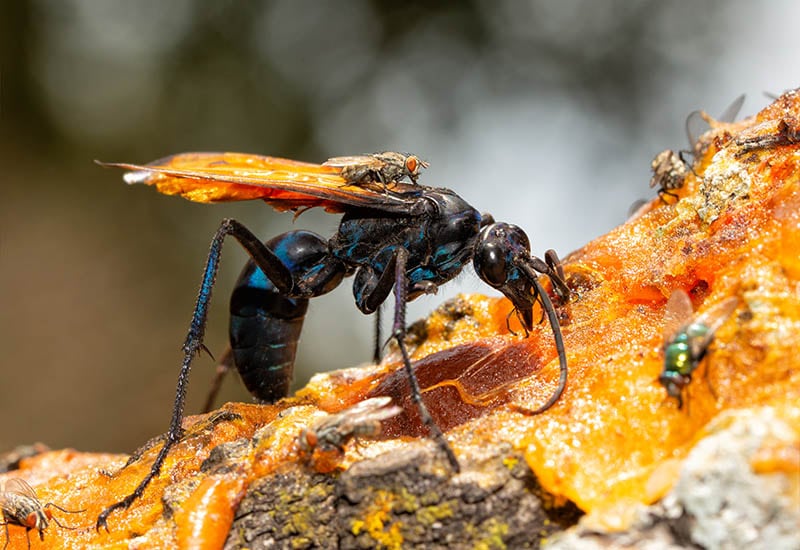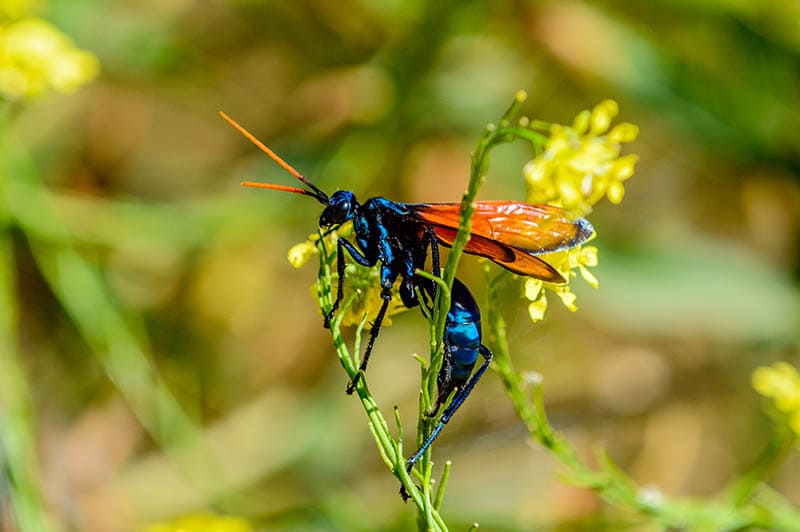What Is the State Insect of New Mexico? How It Was Decided
-
Pete Ortiz
- Last updated:

Animals have long been our companions. Though they are not as intelligent as human beings, the evolutionary course would have taken another route without them. They are a source of food and comfort—which is why we always try to immortalize them by imprinting them on flags, notes, and artwork.
Currently, more than 50 nations have one or more national animals. For example, the US prides itself on the bald eagle, the national animal since 1782. Today it appears on the Great Seal with its spread-out wings and sharp talons, grabbing an olive branch and thirteen arrows.
Immortalizing animals actually started long ago. The Aztecs in present-day Mexico believed that Jaguars and eagles possessed magical powers, which evoked their warriors to put on jaguar skins and eagle head-shaped masks.
Over the border in New Mexico, the tarantula hawk or tarantula hawk wasp became a state insect for unlikely reasons. Let us find out.
How Did the Tarantula Hawk Become NM’s State Insect?
In 1989, a group of elementary students and their teacher from Eaglewood were researching which states had selected state insects. Arkansas, California, and Connecticut adopted the European honey bee, California dogface butterfly, and European praying mantis in 1973, 1972, and 1977, respectively.
This prompted them to select three insects that were native to New Mexico to vote for them as state insects. They mailed ballots to all schools in the state, and not surprisingly, the tarantula hawk impressed many and was voted in favor of. The deadly species was legally selected and adopted by the 39th legislature in 1989. During the bill’s hearing, a group of students from Alaska became interested and attended the session when the bill was being introduced.
Perhaps this triggered Alaska to adopt the four-spotted skimmer dragonfly in 1995 as their state insect.

What Is a Tarantula Hawk Wasp?
A tarantula hawk is a parasitic spider wasp common in hot areas though the species has been observed thriving in colder southern parts of Argentina. It is active in warm conditions, especially in summer, but the wasp retires to shaded regions as heat rockets.
Adult tarantula wasps are docile and live a peaceful life unless provoked. Males are slightly aggressive and will attack with their hypodermic-needle-like stinger and pump a concoction of venom into the victim. The pain is excruciating and simply shuts down your ability to do anything for the next 5 minutes.
The wasps are nectarivorous, meaning they feed on nectar from mostly milkweed, soapberry trees, and mesquite flowers. They also feed on fermented fruits, which sometimes poison their bodies with alcohol to stop them from flying for a few hours.
After foraging, male tarantula hawks have been observed practicing hill-topping. This is mate-location behavior, where a male insect flies to a vantage point and scans the surroundings for passing by females. Tarantulas will chase off any competitors if they stray too close.
A female will mate and burrow down into the sand to prepare a chamber for the egg. But before this happens, she will fly around searching for a tarantula spider. Once located, she will then paralyze it with a well-paced sting between the legs. Females have more potent venom than males, which is why a single sting is enough to paralyze a large spider.
The helpless arachnid will be dragged into the burrow before the female lays a single egg on the spider’s abdomen. The larvae emerge after four days and start feeding on the spider, sparing vital organs for the future. It will eat the heart and the nervous system a few days before pupating. This is the most brutal part of a tarantula hawk’s life cycle and possibly why most people revere it.

Why Was the Tarantula Hawk Chosen as a State Insect?
Given that there are billions of insects out there buzzing for our attention unknowingly, to become a state insect calls for extraordinary qualities. The main reason a tarantula hawk was selected as a state insect was it was voted for. However, what swayed students’ decisions to its advantages is not yet clear. Here are some possibilities.
1. It is one of the largest wasp species
In the realm of invertebrates, being large coupled with a painful sting calls for celebrity status. A tarantula is almost 2 inches long, making it one of the largest wasps. The stinger averages 0.2 inches long in males and 0.25 in females.
2. Vibrant colors
Tarantulas have dark blue to black iridescent bodies with rusty wings. Iridescence is an optical phenomenon where the body surface appears to change color as the angle of view changes. Scientifically known as aposematism, the vivid coloration is to tell potential predators to steer clear.
3. Hunts spiders several times their weight
While a female wasp is less than 2 inches long and 0.02 ounces, it hunts tarantula spiders whose leg spans over 11 inches wide and weighs almost 3 ounces. Capturing such a large specimen is difficult, so the female flashes the spider out of the burrow and uses speedy maneuvers to land a sting.
4. The wasp is incredibly strong
Protected by a hardened exoskeleton, spider wasps are tough insects. The exoskeleton extends from the head to the abdomen. On the abdomen, it forms plates or sclerites for flexibility.
Besides protecting internal organs, the tough exoskeleton allows the wasp to take on large spiders without fear of injuries.

Does New Mexico Have Another State Insect?
Surprisingly, like North Carolina, Kentucky, and Delaware, NM has more than one state insect. The Sandia hairstreak (Callophrys mcfarlandi) has been the state’s butterfly since 2003. Discovered by Noel McFarland in the spring of 1958 in La Cueva Canyon, Albuquerque, the hairstreak is a relatively small butterfly with a wing span of less than 2 inches.
The wing’s upper side is reddish-brown, while the underside is jade green with a narrow black border around the edge. This beautiful coloration is to allow the butterfly to camouflage with the surroundings as it folds its wings.
Most hairstreak species likely got their name from hair-like tails that extend from the wings. They resemble antennas to fool predators, and if a lizard or bird falls for this trick, the butterfly will only lose a small part of its wing.
Conclusion
From the most dangerous to the most striking, New Mexico’s state insects are stunning. The tarantula wasp is an accomplished killer with a beautiful body and speedy maneuvers. The insect is famed for its excruciatingly painful sting, and most people want to leave it undisturbed.
On the other hand, the Sandia hairstreak is an approachable butterfly with a long list of predators. But it has managed to live for millions thanks to camouflage and fooling techniques.
Featured Image Credit: Richard Stephen, Shutterstock
Contents




